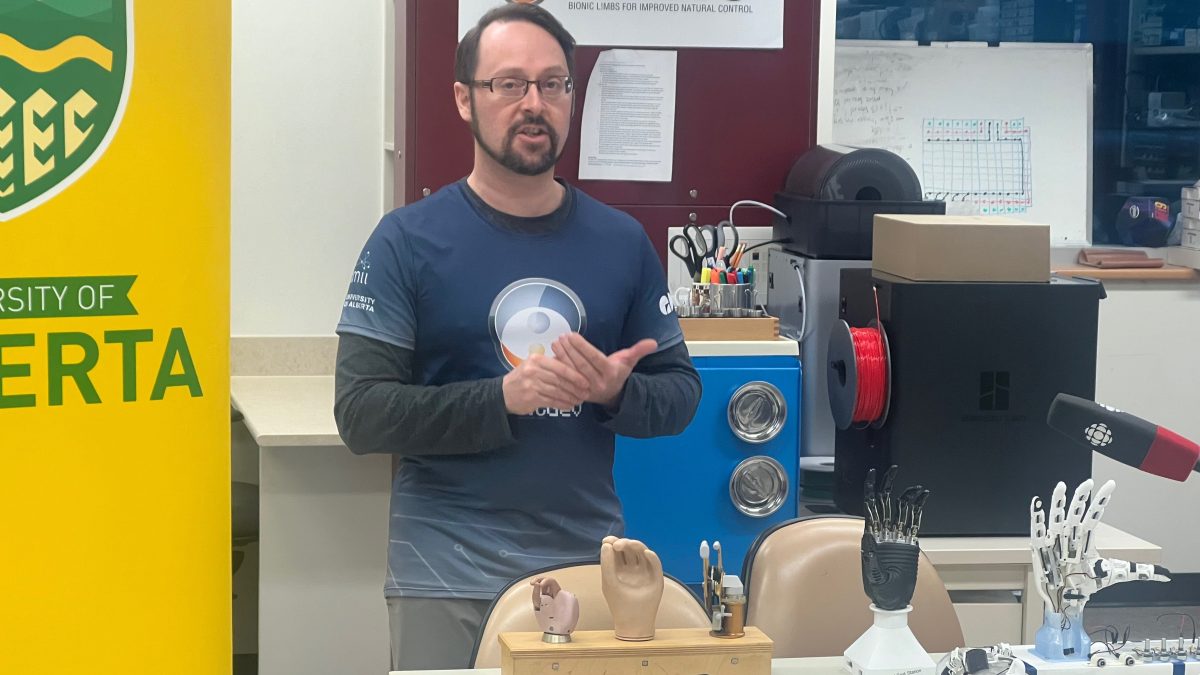I am a child of the 1970s. So, to me, the word “bionic” meant Steve Austin and Jaime Sommers, two people given superpowers thanks to their mechanically augmented bodies. It meant matching track suits. It meant having to fight Bigfoot at ratings sweeps time.
(For those of you who are too young for this analogy, Google The Six Million Dollar Man and/or The Bionic Woman. Yes, your parents lived for this. Trust me.)
Steve Austin. Astronaut. A Man Barely Alive.
So, when I was placed on the media invite list to visit the University of Alberta’s Bionic Limbs for Improved Natural Control (BLINC) lab, I was pretty excited. While the team at the lab didn’t have matching bright red track suits, they did wear their blue team shirts that they had made for the just-completed Cybathlon.
Oh, boy, Cybathlon. No, it’s not a super-villain who first appeared in The Mighty Avengers No. 117. It’s an international competition that sees teams from more than 30 countries go prosthetic-limb-to-prosthetic-limb in challenges that determines who makes the smartest, most dextrous and most adaptable “assistive technologies” in the world.
The BLINC lab sent a team of eight with its Bento Arm, wielded by amputee Chris Neilson. When they returned from the competition, Neilson and the team showed off the arm, what it can do — and talked about what it could mean for the future.
It’s a 600-gram arm — compared to the 2.5-kilogram prosthetic Neilson usually wears. It uses artificial intelligence to learn how the user wants it to move. It was manufactured by a 3D printer.

Sensors placed on Neilson’s upper arm that translate muscle signals. The sensors detect the electrical impulses under the skin that naturally occur when we want our hands or arms to move.
“There are sensors all over my arm. So, when I imagine rotating my elbow, it flexes weird muscles and it picks up that weird pattern. That translates into a switch, which then rotates the wrist or the elbow.”
This isn’t new — but the addition of machine learning is. This means the arm can “learn” what Neilson wants it to — so it can better perform tasks that he normally would do during the course of Cybathlon. In a real-world application, it would learn the user’s everyday tasks, and be able to adapt to them.
Gentlemen, we can rebuild him. We have the technology.
“What comes out of labs like this, and participating in Cybathlon, is that we design technology that keeps users in mind and it allows them to live the lives they want to live,” says Patrick Pilarski, professor of physical medicine and rehabilitation at the U of A, and the Canada CIFAR (Canadian Institute for Advanced Research) Artificial Intelligence Chair. “The whole event, the multinational competition, was designed to truly stress test rehabilitation and assistive technologies, so they can do the things that people need them to do.”
So, Neilson used the Bento Arm to hold a wand, and lead it through a bending maze. He had to pick up a marble, credit card, Lego block and key and place them in appropriate places on a block. These require fine motor skills.
“The trap is that people often think, ‘let’s create cool technology,’” says Pilarski. “Cybathlon forces researchers and users to work together to build technologies that truly enable people to express themselves and live in their communities.”
We have the capability to make the world’s first Bionic man. Steve Austin will be that man.
“Machine learning takes on some of that burden,” says Pilarski. “By allowing Chris to show some of the patterns that he wants the machine to do, by showing the machine how he wants it to behave, to be able to allow the machine to take on some of the role of programming, it allows Chris to better customize the system.”
Even though what the BLINC lab is doing can make the layperson’s jaw drop, it’s not proprietary. The lab’s coding is sent out to the world. It’s open-source technology. Pilarkski makes it clear that the work is about benefitting humankind as a whole.
The research is supported by the Glenrose Hospital Foundation (GHF).
“The potential is limitless,” says Mark Korthuis, president and CEO of GHF. “The technologies are advancing so quickly.”
He says that Edmonton is a global leader in rehabilitative technologies — and he thinks those advances will soon leave the lab and be available to the Glenrose’s patient population.
“I can see applications within the next five years becoming commercially available, and ultimately available to patients in Alberta and around the world… For patients, I would say ‘hope’ is the one word that comes to mind. It can sound trite, but when somebody sees that there’s potential applications to use an artificial limb, just in the way they’d use any regular limb, it gives them hope for the future.”
Better than he was before. Better. Stronger. Faster.
Savvy AF. Blunt AF. Edmonton AF.




